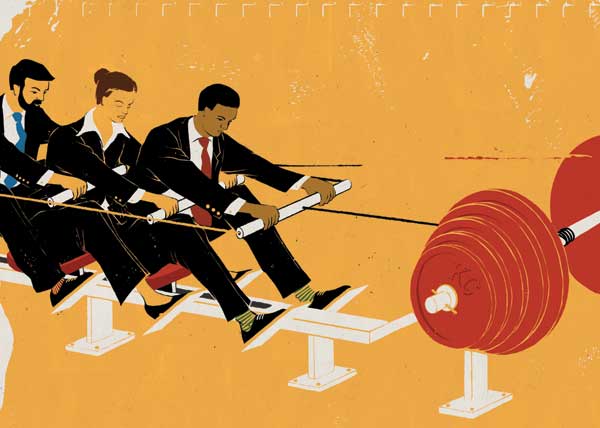1 September 2011 | By Pam Jones
The need for staff to pull together has never been more important as bigger workloads, tighter targets, redundancies and uncertainty take their toll. Pam Jones explains how to build teams that can thrive in these turbulent times
 The public sector is going through unprecedented change. With 132,000 jobs lost this year and an estimated 490,000 to go before 2014/15, the situation for teams is grim. The effects of colleagues leaving, extra responsibilities, spending cuts and the erosion of personal benefits are testing the resilience of even the hardiest.
The public sector is going through unprecedented change. With 132,000 jobs lost this year and an estimated 490,000 to go before 2014/15, the situation for teams is grim. The effects of colleagues leaving, extra responsibilities, spending cuts and the erosion of personal benefits are testing the resilience of even the hardiest.
More than ever, leaders have an important role in developing and mobilising their teams. They need to channel the feelings of loss and low morale into positive forward-looking energy. Team members will need to be able to support each other in practical and emotional ways as they navigate through the changes.
Whatever challenges individual teams face, they will all have to work well together and become more innovative if they are to continue to provide public value with tougher workloads.
Being part of a successful team goes a long way to creating a sense of group involvement. Research from Hay and the Gallup organisation shows that this in turn leads to enhanced results, greater creativity and fewer sick days. So teamwork is not a ‘nice to have’ but an essential part of achieving success in the public sector.
Below are ten practical steps leaders can take to develop and enhance the performance and morale of their teams.


The need for staff to pull together has never been more important as bigger workloads, tighter targets, redundancies and uncertainty take their toll. Pam Jones explains how to build teams that can thrive in these turbulent times
 The public sector is going through unprecedented change. With 132,000 jobs lost this year and an estimated 490,000 to go before 2014/15, the situation for teams is grim. The effects of colleagues leaving, extra responsibilities, spending cuts and the erosion of personal benefits are testing the resilience of even the hardiest.
The public sector is going through unprecedented change. With 132,000 jobs lost this year and an estimated 490,000 to go before 2014/15, the situation for teams is grim. The effects of colleagues leaving, extra responsibilities, spending cuts and the erosion of personal benefits are testing the resilience of even the hardiest.More than ever, leaders have an important role in developing and mobilising their teams. They need to channel the feelings of loss and low morale into positive forward-looking energy. Team members will need to be able to support each other in practical and emotional ways as they navigate through the changes.
Whatever challenges individual teams face, they will all have to work well together and become more innovative if they are to continue to provide public value with tougher workloads.
Being part of a successful team goes a long way to creating a sense of group involvement. Research from Hay and the Gallup organisation shows that this in turn leads to enhanced results, greater creativity and fewer sick days. So teamwork is not a ‘nice to have’ but an essential part of achieving success in the public sector.
Below are ten practical steps leaders can take to develop and enhance the performance and morale of their teams.
1. Set clear goalsPam Jones is a director of Ashridge Business School’s ‘Performance through people’ programme and the author of Managing for performance, published by Pearson Prentice Hall
Teams need clear goals and a sense of purpose so they know what they are aiming for. The trick is for goals to be challenging but achievable, so break them down into objectives that the team can relate to. Once people are aware of the outcome and what they need to achieve, they can focus their energy on providing best value and monitor their progress towards this.
2. Review progress on a regular basis
Teams respond well to regular reviews where they can see how they are progressing towards their goal. It is important not just to review the task at hand but ‘how’ you are all working together. Take five minutes at the end of the meeting to review what went well and what you could improve on for next time.
3. Ensure everyone understands their role and accountability
A hallmark of a high performance team is that they are a group of people who are accountable to one another in order to achieve a shared goal. As team structures are changing, it is important that everyone understands their role and how it dovetails into the work of others. In addition, as services are becoming more streamlined, this might require teams to focus on overall service provision and recognise their accountability in achieving the outcome needed.
4. Develop clear channels for communication
You need to decide the best way to communicate with your team – one-to-one meetings, regular team meetings, newsletters or conference calls. The secret is to find a way to create regular updates so the team feels involved and knows what is happening. This is one area where you can get feedback: what will help the team function to their potential?
5. Listen and involve others
Spending time listening to your team is probably one of the best things you can do. Not only will it help them to feel valued but it will encourage them to come up with new ideas and contribute to achieving the team goals. Team meetings are an ideal opportunity to brainstorm ideas and focus on developing solutions, allowing staff to come up with practical ideas on how to improve services.
6. Understand your team
Getting to know your team as individuals and helping them to understand each other can help to create a greater sense of team. Spending some social time together, doing some team building or just working on a joint project are all ways of increasing this understanding. If team members understand each other they will be much more likely to manage conflict effectively and support each other to achieve their goals.
7. Manage poor performance
One of the things that can really lower team morale is when the team is not ‘pulling together’. If just one member is performing below standard this can affect the overall balance of the group. By managing poor performance as it arises you are not only improving the performance of that individual but influencing the overall motivation and performance of the team.
8. Develop, delegate and coach
As a leader it is important to develop your team into a high performing group where everyone is working to their potential. This requires spending time identifying areas of development for each team member and coaching them. The link between coaching and delegation is important because you can look at linking the tasks you need to develop with the development needs of your team. Remember, you can also use experienced team members to coach and develop the newer members.
9. Celebrate success and praise good performance
Remembering to celebrate success is an important element of good teamwork. High performing teams are teams that achieve on targets and celebrate before moving on. Public sector teams are increasingly under pressure to meet a whole array of targets. Taking a bit of time to celebrate and praise people for their good work can provide a focus for the team and a feeling of achievement and progress.
10. Lead by example
Finally, team leaders must set a good example. Your motivation and enthusiasm will directly influence everyone else. Team members will be looking to you for advice, support and leadership. Your standards will become their standards so take a few moments to reflect on your approach. What sort of leader do you want to be? And what sort of team do you want to create?




















